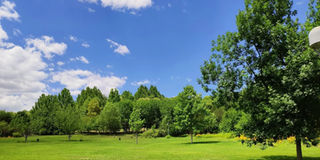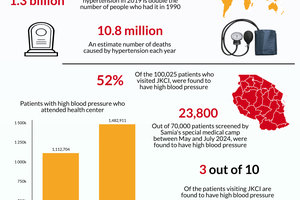
World Hypertension Day is celebrated annually on May 17. It serves as a critical platform for raising awareness about hypertension and promoting its prevention, detection, and management. This year (2025) marks the 20th anniversary of this observance, under the compelling theme, “Measure your Blood Pressure accurately, Control it, Live Longer!"
Hypertension, often referred to as a silent killer, is a leading public health challenge due to high prevalence among adults. Hypertension, or high blood pressure, was not that common in Africa, but, in recent decades, “socio-economic development”, which has entailed less physical exercises and less reliance on traditional foods, accompanied by more exposure to pollution and stress, especially in urban areas, has resulted into the incidence of “pressure” now becoming a household name.
Urban living often involves high levels of stress due to work and economic pressures, traffic, noise, pollution and other environmental factors, poor housing environment, overcrowded and risky transport modes, and other problems.
Among others, African urban areas are poorly endowed with open spaces, greenery and provisions for non-motorized transport; yet these would be very useful in reducing the incidence of hypertension among urban residents.
For some commentators, urban open spaces are seen as publicly accessible places designed and kept from human activity and enjoyment. These include parks, community gardens, children’s playing areas, green corridors, urban civic plazas and squares, pedestrian streets, market places, general play grounds, bicycle lanes or running tracks, and botanical gardens. This definition may exclude open spaces in private spaces.
For other authorities open spaces mean land that is not intensively developed for residential, commercial, industrial or institutional uses. Such spaces serve many purposes, whether it is publicly or privately owned.
Such open spaces include agricultural and forest land, undeveloped water fronts, undeveloped scenic lands, public parks and preserves, green belts, and urban water bodies such as lakes, bays, pools, river valleys and wetlands.
Many African public authorities, and the general population, may consider “open spaces” unimportant, and as land that is yet to be allocated to a proper use. Open spaces are therefore not abundantly provided for, and are practically missing in informal areas; and those that may have been provided for in the past, are easily converted to other uses as time passes by. Nevertheless, urban open spaces and biological growth, such as trees, have numerous advantages.
Urban vegetation in open spaces especially trees improve air quality by adding oxygen and removing pollutants. Green spaces with less pavement or concrete, have a cooling effect, reducing city temperatures in hot seasons. This, in turn, could leads to a saving in cooling costs for buildings. In this age of global warming, cooling the urban atmosphere need not be overemphasized. A cooler urban environment can assist in reducing stress and therefore, hypertension.
Urban activities and concreting lead to higher urban temperature compared to rural areas. Greening a city improves its microclimate, reducing heat and warming, and need for cooling.
Impermeable urban surfaces lead to fast water run-offs and flooding. Vegetated surfaces absorb much of rainfall, slow down the process of surface runoff reaching flooding stage. Protecting urban rivers, micro-lakes, pools, wetlands, helps in controlling flooding and erosion, and reduces stress among urban residents.
Trees are carbon dioxide (CO2) vacuums that bring balance to the ecological system. They also utilize carbon dioxide from the environment for photosynthesis, to produce hydrocarbons that aid growth. Trees can also store carbon dioxide for immediate and long-term growth.
Trees can reduce, block or buffer air, noise and water pollution all of which are considerably higher in cities; and thus, address related diseases and disorders, including hypertension.
Greening of a city creates space for all creatures to come together uniting humans and nature. Closeness to nature can lead to the reduction of stress. Besides, many plants have medicinal properties which can be used together with or as an alternative to, standard medicine.
Open spaces such as parks, walking trails, playgrounds and fields are great areas for recreation, particularly for children. They encourage people to walk and exercise by providing places for physical activities, as individuals or as organized groups, at little or no cost. This is important for the aged, and those convalescing, who need to regularly go out and have fresh air and a dose of sunshine; as well as those who are at the risk of hypertension and diabetes.
Open spaces also boost a sense of well-being by availing calm places to stop and think without the city noise, hustle and bustle. This helps reduce stress by providing a respite from the city, which is good for mental health.
Urban authorities as well as urban residents in African cities need to appreciate the importance of open spaces and urban trees sense they can play a crucial role in contributing to the reduction of urban stress, and thus hypertension. They, thus, need to be provided for, and protected.

